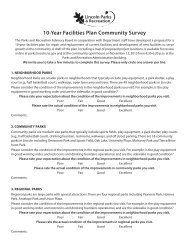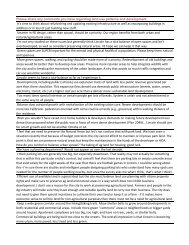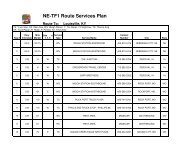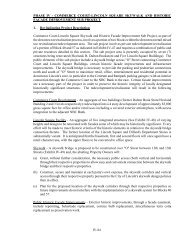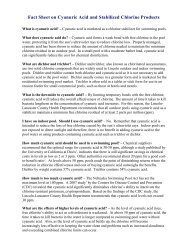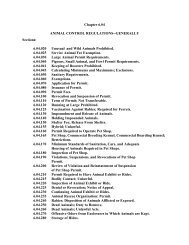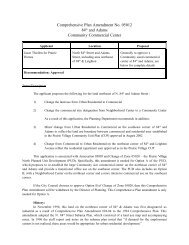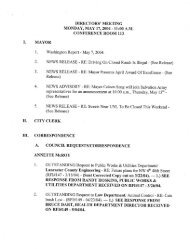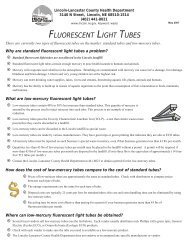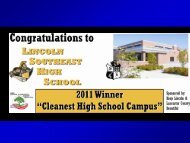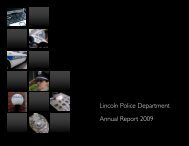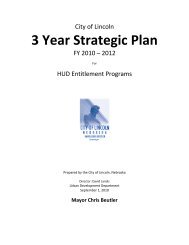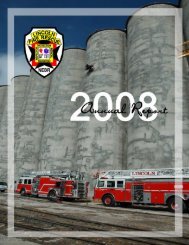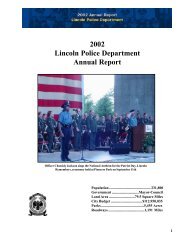City of Lincoln Personal Protective Equipment Policy
City of Lincoln Personal Protective Equipment Policy
City of Lincoln Personal Protective Equipment Policy
Create successful ePaper yourself
Turn your PDF publications into a flip-book with our unique Google optimized e-Paper software.
I. Purpose<br />
<strong>City</strong> <strong>of</strong> <strong>Lincoln</strong><br />
<strong>Personal</strong> <strong>Protective</strong> <strong>Equipment</strong> <strong>Policy</strong><br />
The purpose <strong>of</strong> this policy is to ensure that workplace hazards are identified and that personal<br />
protective equipment is provided to all employees who work in hazardous conditions. The<br />
transmittal <strong>of</strong> this information is to be accomplished by this policy, to include a hazard<br />
assessment, equipment selection and employee training.<br />
II. Introduction<br />
The Federal OSHA <strong>Personal</strong> <strong>Protective</strong> <strong>Equipment</strong> (PPE) Standard, 29 CFR 1910.132 deals with<br />
personal protective equipment that is used in the workplace.<br />
This standard requires employers to provide equipment and training to each employee who is<br />
required to use <strong>Personal</strong> <strong>Protective</strong> equipment.This applies to all work operations <strong>of</strong> the <strong>City</strong> <strong>of</strong><br />
<strong>Lincoln</strong> where employees may be exposed to workplace hazards. Employees shall use <strong>City</strong><br />
approved personal protective equipment in the workplace.<br />
III. <strong>Equipment</strong> Criteria<br />
In determining the proper protective equipment to be used by employees, the <strong>City</strong> <strong>of</strong> <strong>Lincoln</strong> will<br />
rely on information provided by manufacturers, using the following sources, as set out by the<br />
above federal standard and the NFPA.<br />
1. ANSI Z87.1-1989 American National Standard Practice for Occupational and Educational<br />
Eye and Face Protection.<br />
2. ANSI Z88.2-1980 American National Standard Practices for Respiratory Protection.<br />
3. ANSI Z89.1-1986 American National Standard for Personnel Assurance Protection -<br />
<strong>Protective</strong> Headwear for Industrial Workers - Requirements.<br />
4. ANSI Z41-1991 American National Standard for <strong>Personal</strong> Protection - <strong>Protective</strong> Footwear.<br />
1
IV. Responsibility<br />
Department Heads Have the Responsibility to:<br />
1. Implement this policy by:<br />
A. Directing supervisors to assess all hazards in their work environment and to<br />
identify employees this may affect.<br />
B. Providing all employees with information, training and the equipment they need<br />
to protect themselves and others.<br />
C. Ensuring that all necessary equipment is available to comply with this policy.<br />
2. Enforce compliance with this policy. All affected employees, presently employed and all<br />
new employees, must be trained and responsible for the purpose and use <strong>of</strong> this policy.<br />
Supervisors have the responsibility to:<br />
1. Identify and assess the hazards in their work environment, and provide employees with<br />
the information, training and equipment they need to protect themselves and others.<br />
2. Enforce compliance with this policy.<br />
Employees Have the Responsibility to:<br />
1. Understand their assigned tasks relating to personal protective equipment.<br />
2. Apply the proper training and equipment to safely work in hazardous areas.<br />
3. Assist with the assessment and identification <strong>of</strong> hazardous areas.<br />
4. Comply with the directives <strong>of</strong> this policy.<br />
Purchasing Has the Responsibility to:<br />
1. Review and standardize personal protective equipment for the <strong>City</strong> except for specialty<br />
equipment <strong>of</strong> the Police and Fire Departments.<br />
2. Contract for personal protective equipment to be requisitioned by all departments, except<br />
for specialty equipment <strong>of</strong> the Police and Fire Departments.<br />
2
Risk Management Has the Responsibility to:<br />
1. Train appropriate supervisors and employees in this policy, except for specialty<br />
equipment <strong>of</strong> the Police and Fire Departments.<br />
2. Assist in the assessment <strong>of</strong> work area hazards, to include the type <strong>of</strong> hazard,<br />
recommended personal protective equipment, employees affected and training required.<br />
3. Audit and evaluate each department's compliance with this policy on an annual basis.<br />
The effectiveness <strong>of</strong> this policy shall be evaluated annually and corrective action taken to<br />
eliminate defects found in the policy.<br />
V. Written <strong>Personal</strong> <strong>Protective</strong> <strong>Equipment</strong> Program<br />
The <strong>City</strong> <strong>of</strong> <strong>Lincoln</strong> relies upon the cooperation <strong>of</strong> each department/division/section in order to<br />
complete the following:<br />
1. Identify hazardous environments in the workplace.<br />
2. Select, and have affected employees utilize, the types <strong>of</strong> PPE that will protect employees<br />
from identified hazards.<br />
3. Communicate selection decisions to affected employees.<br />
4. Train affected employees to recognize when protective equipment use is required, and the<br />
proper use and care <strong>of</strong> this equipment.<br />
Hazard Assessment<br />
An assessment <strong>of</strong> workplace hazards, or potential hazards, shall be completed for each<br />
workplace. The assessment shall include the type <strong>of</strong> hazard, recommended protective equipment,<br />
employees affected, and training requirements.<br />
1. Select the type <strong>of</strong> protective equipment that will protect affected employees from<br />
identified hazards.<br />
2. Communicate selection decisions and provide necessary equipment to affected<br />
employees.<br />
3. Provide the proper fitting <strong>of</strong> protective equipment for each affected employees.<br />
3
Training<br />
Each employee who is required to wear protective equipment as determined by the hazard<br />
assessment shall be properly trained in the use and care <strong>of</strong> this equipment.<br />
1. Each affected employee shall be trained to know at least the following:<br />
A. When protective equipment is necessary;<br />
B. What protective equipment is necessary;<br />
C. How to properly put on, take <strong>of</strong>f, adjust, and wear protective equipment;<br />
D. The limitations <strong>of</strong> protective equipment and,<br />
E. The proper care, maintenance, useful life and disposal <strong>of</strong> the protective<br />
equipment.<br />
2. Each affected employee shall demonstrate an understanding <strong>of</strong> the training specified<br />
above, and the ability to use the equipment properly, before being allowed to perform<br />
work requiring the use <strong>of</strong> protective equipment.<br />
3. When the employer has reason to believe that any affected employee who has been<br />
trained does not meet the conditions in the above section the employee shall be<br />
retrained. Circumstances where an employee may need retraining include, but are not<br />
limited to, situations where:<br />
A. Changes in the workplace render previous training obsolete; or<br />
B. Changes in the types <strong>of</strong> protective equipment render previous training<br />
obsolete; or<br />
C. Inadequacies surface in an affected employee's knowledge or use <strong>of</strong><br />
assigned protective equipment.<br />
4. The department shall verify that all affected employees have successfully completed<br />
training on required protective equipment as called for in the above section under training<br />
through proper documentation, to includes the employee's name, date <strong>of</strong> training, and<br />
subject <strong>of</strong> training.<br />
5. It is the responsibility <strong>of</strong> all <strong>City</strong> contractors / consultants to comply with 29 CFR<br />
1910.132 regarding personal protective equipment. <strong>City</strong> employees should make every<br />
effort to identify any hazards that are not immediately obvious to consultants or<br />
contractors.<br />
4
However, it is the contractors or consultants responsibility to inform his/her own<br />
employees about these hazards and precautions required by the above standard. The<br />
information provided by <strong>City</strong> employees should be used as a guide only, with final<br />
determination to rest with the contractor or consultant.<br />
VI. Eye and Face Protection<br />
Regulatory requirement are contained in 29 CFR 1910.133<br />
Each affected employee:<br />
1. Shall use approved eye and face protection when exposed to hazards from flying<br />
particles, molten metal, liquid chemicals, acids or caustic liquids, chemical gases or<br />
vapors, or potentially dangerous light radiation.<br />
2. Shall use eye protection which provides side protection when there is a hazard <strong>of</strong> flying<br />
objects.<br />
3. Shall wear prescription lenses while engaged in operations which involve eye hazards.<br />
Employees shall wear approved eye protection which incorporates the prescription in<br />
the design, or eye protection that can be worn over prescription lenses without<br />
disturbing the proper position <strong>of</strong> the prescription or protective lenses.<br />
4. Shall use equipment with filter lenses that have a filter number adequate for the work<br />
being performed for protection from injurious light radiation.<br />
The usual recommended lens shade for electric arc welding is 10, 11 or 12 while the<br />
usual recommended lenses shade for oxy-acetylene is 5, 6, or 7.<br />
5. Eye and face protective equipment shall bear the manufacturers identification mark.<br />
VII. Head Protection<br />
Regulatory requirement are contained in 29 CFR 1910.135<br />
1. Each affected employee shall wear approved head protection when working in areas<br />
where there is a possibility <strong>of</strong> injury from falling objects.<br />
2. Each affected employee shall wear approved head protection when working in areas<br />
near exposed electrical conductors which could contact the head.<br />
3. <strong>Protective</strong> helmets shall be regularly cleaned by the affected employee and inspected<br />
for defects, such as cracks and dents. Any helmet with damage or defects, if it effects<br />
the structural integrity <strong>of</strong> the helmet, shall be replaced.<br />
5
4. <strong>Protective</strong> helmets shall be stored out <strong>of</strong> direct sunlight, and application <strong>of</strong> nonapproved<br />
decorations, logos or other markings is prohibited.<br />
VIII. Foot Protection<br />
Regulatory Requirement are contained in 29 CFR 1910.136<br />
1. Affected employee shall wear approved foot protection when working in areas where<br />
there is a possibility <strong>of</strong> foot injuries due to falling or rolling objects, objects piercing the<br />
sole, and where the feet are exposed to electrical hazards.<br />
2. Proper care and maintenance <strong>of</strong> safety footwear shall be provided by the employee.<br />
Inspections for defects that effect employee safety, shall be made on a regular basis.<br />
IX. Hearing Protection<br />
Regulatory Requirement are contained in 29 CFR 1910.95<br />
1. Each affected employee shall be provided approved hearing protection against the<br />
effects <strong>of</strong> noise exposure when the sound levels in the workplace exceed certain limits.<br />
2. In cases where the noise levels consistently exceed allowable limits, the <strong>City</strong> shall<br />
institute and administer a continuing, effective hearing conservation program. This<br />
program should include:<br />
A. The effects <strong>of</strong> noise on hearing;<br />
B. The purpose <strong>of</strong> using hearing protection, the advantages and disadvantages<br />
<strong>of</strong> various types <strong>of</strong> equipment;<br />
C. Instructions on selection, fitting, use, and care <strong>of</strong> hearing protectors; and<br />
D. The purpose <strong>of</strong> audiometric testing and an explanation <strong>of</strong> the test procedure.<br />
3. The supervisor is responsible for ensuring that devices are properly fitted and are used<br />
correctly by the employee.<br />
4. Proper care and maintenance shall be given to hearing protection equipment. Reusable<br />
plugs shall be inspected before each use for cracks and defects.<br />
5. Defective and/or disposable plugs shall be disposed <strong>of</strong>, and not reused.<br />
6
6. Ear muffs shall form a tight seal around the ears. During regular inspections, check seals<br />
for cracks and loose headbands.<br />
X. Hand Protection<br />
Regulatory Requirement are contained in 29 CFR 1910.138<br />
1. Each affected employee shall wear approved hand protection when exposed to hazards<br />
such as those from skin absorption <strong>of</strong> harmful substances; cuts and lacerations;<br />
abrasions; punctures; chemical burns; thermal burns; and harmful temperature extremes.<br />
2. Work activities shall be assessed to determine the proper type <strong>of</strong> glove for the<br />
environment involved.<br />
3. All hand protection shall be properly cared for and regularly inspected for defects and<br />
holes. All disposable and/or defective equipment shall be disposed <strong>of</strong> properly.<br />
XI. <strong>Protective</strong> Clothing<br />
Regulatory requirements are contained in 29 CFR 1910.120 Hazardous waste operations,<br />
emergency response.<br />
1. Each affected employee shall wear approved protective clothing when exposed to<br />
conditions where skin absorption <strong>of</strong> a hazardous substance could occur.<br />
2. All protective clothing that is non-disposable shall be properly cleaned and disinfected<br />
after each use. Disposable equipment shall be properly discarded. Regular inspections<br />
shall be made for tears or rips, seam discontinuities or pin holes. Immediately dispose <strong>of</strong><br />
any defective clothing.<br />
3. Clothing shall be stored in the following manner:<br />
A. Potentially contaminated clothing shall be stored in an area separate from street<br />
clothing.<br />
B. Potentially contaminated clothing shall be stored in a well-ventilated area, with<br />
good air flow around each item, if possible.<br />
C. Different types <strong>of</strong> clothing shall be stored separately to prevent issuing the<br />
wrong material by mistake.<br />
D. <strong>Protective</strong> clothing shall be folded or hung in accordance with manufacturer's<br />
recommendations.<br />
7
XII. Respiratory Protection<br />
Regulatory Requirement are contained in 29 CFR 1910.134<br />
1. Elements <strong>of</strong> the Respiratory Protection Program shall include:<br />
A. Written standard operating procedures governing the selection and use <strong>of</strong><br />
respirators as indicated within.<br />
B. Respirators shall be selected based on hazards to which the worker is exposed.<br />
C. All affected employees shall be trained in the proper use, selection and<br />
maintenance <strong>of</strong> respirators, and their limitations.<br />
D. Respirators shall be regularly cleaned and disinfected, and stored in a sanitary<br />
container or location.<br />
E. Respirators shall be regularly inspected for worn or deteriorated parts, which<br />
shall be replaced upon detection.<br />
F. Appropriate review <strong>of</strong> workplace conditions and degree <strong>of</strong> exposure<br />
shall be maintained.<br />
G. Respirator guidelines do not apply to specialized Police Department<br />
operations or equipment where tear gas or pepper spray is utilized for<br />
crowd control or suspect apprehension.<br />
2. Selection <strong>of</strong> Respirators<br />
The <strong>City</strong> <strong>of</strong> <strong>Lincoln</strong> shall select its respirator equipment in accordance with the regulations set<br />
forth in the following:<br />
A Material Safety Data Sheet (MSDS) permissible exposure limits;<br />
B. American National Standard Practices for Respiratory Protection Z88.2-1980;<br />
C. Mine Safety and Health Administration (MSHA) .<br />
D. National Institute for Occupational Safety and Health (NIOSH) approvals.<br />
E. Occupational Safety and Health Administration (OSHA) Code <strong>of</strong> Federal<br />
Regulations, Title 29, Part 1910, Subpart I, Subsection 1910.134.<br />
8
A Respirator Selection Guidelines chart is attached. See Appendix A.<br />
3. Use <strong>of</strong> Respirators<br />
A. When effective engineering controls are not feasible, appropriate respirators<br />
shall be used by all affected employees.<br />
B. Respirators shall be issued by a supervisor or a designated employee on an<br />
individual basis for the employee's exclusive use. Respirators shall be clearly<br />
marked to identify the person to whom the unit is assigned.<br />
4. Fit Testing<br />
A. Employees shall be properly fitted for their own personal respirator before<br />
performing work requiring the use <strong>of</strong> a respirator.<br />
B. Affected employees shall receive a qualitative fit test, including demonstrations<br />
and practice in how the unit should be worn, how to adjust it and how to<br />
determine if it fits properly, in the training sessions.<br />
C. Facial hair prevents the proper seal <strong>of</strong> a respirator. Employees shall have facial<br />
hair removed before a respirator can be properly fit tested.<br />
5. Respirator Certifications<br />
A. Employees shall be determined physically able to wear a respirator, by a<br />
physician, before performing work requiring the use <strong>of</strong> a respirator.<br />
A sample respiratory medical release form may be found in Appendix<br />
B.<br />
B. A <strong>City</strong> <strong>of</strong> <strong>Lincoln</strong> health care provider, or qualified designee, shall determine<br />
what health and physical conditions are pertinent.<br />
6. Training<br />
A. All affected employees shall be trained in the proper use <strong>of</strong> respirators and<br />
informed <strong>of</strong> their limitations.<br />
B. Training shall allow the employee to handle the respirator, have it properly<br />
fitted, wear it in normal atmosphere, and wear it in a test atmosphere.<br />
C. Annual training will include information regarding:<br />
1) The nature <strong>of</strong> the respiratory hazard, and what may happen if the unit is not<br />
9
used properly.<br />
2) Engineering and administrative controls being used, and the need for<br />
additional respiratory protection.<br />
3) Reasons for selecting a particular type <strong>of</strong> respirator.<br />
4) Cleaning and storage methods.<br />
5) Inspection and maintenance procedures.<br />
6) Limitations <strong>of</strong> the selected respirator.<br />
7) Recognizing warning labels and signs.<br />
8) Qualitative fit test procedures.<br />
7. Respirator Service Life<br />
A. The service life in which air-purifying elements can provide adequate respiratory<br />
protection depends on the specific nature <strong>of</strong> the air contaminant, the<br />
concentration <strong>of</strong> the contaminant in the work atmosphere, and the breathing rate<br />
<strong>of</strong> the user.<br />
B. The replacement <strong>of</strong> air-purifying elements shall be done in a safe area containing<br />
non-contaminated, breathable air.<br />
C. Whenever the respirator wearer experiences either difficulty in breathing<br />
through the air-purifying elements, or odor or taste while inhaling, is a sign that:<br />
8. Recordkeeping<br />
1) The filter portions have become plugged with retained particulate matter; or<br />
2) The cartridge portions have been penetrated by the vapor or gas.<br />
When this occurs, the filter and/or cartridge must be replaced.<br />
A respirator fit test record will be kept for each employee who is, or may be, required to wear a<br />
respirator to fulfill their job requirements. This record will be completed upon completion <strong>of</strong><br />
the fit test, and must be updated with any change in the type <strong>of</strong> respirator used, or any other<br />
condition affecting the effectiveness <strong>of</strong> respiratory equipment. See sample form in Appendix<br />
C.<br />
9. Self-Contained Breathing Apparatus (SCBA)<br />
A. SCBA shall only be used by qualified, trained employees.<br />
B. Parts from one unit may not be exchanged with another.<br />
C. Affected employees shall place special emphasis on care and maintenance <strong>of</strong><br />
SCBA.<br />
10
D. Always follow manufacturer’s recommendations in regards to use, inspection,<br />
cleaning and storage <strong>of</strong> SCBA.<br />
1) SCBA shall be inspected at least every month.<br />
2) A record shall be kept <strong>of</strong> inspection dates and findings,<br />
unless inspections are more frequent than monthly.<br />
Questions concerning this policy will be addressed by:<br />
Risk Management<br />
233 south 10th Street<br />
<strong>Lincoln</strong>, NE 68508<br />
441-7671<br />
11
APPENDIX A<br />
RESPIRATOR SELECTION GUIDELINES<br />
Oxygen Deficiency<br />
HAZARD RESPIRATOR<br />
- Immediately dangerous to life or health* Self-contained breathing apparatus (SCBA)<br />
- Not immediately dangerous to life or health SCBA; Any supplied-air respirator<br />
Gas and Vapor Contaminates<br />
- Immediately dangerous to life or health* Positive-pressure, SCBA; Combination<br />
positive-pressure supplied-air respirator and<br />
auxiliary self-contained air supply.<br />
- Not immediately dangerous to life or health Any supplied-air respirator; Gas mask;<br />
Chemical cartridge respirator.<br />
Particulate Contaminates Any supplied-air respirator including abrasive<br />
blasting respirator; Any air-purifying<br />
respirator with particulate filter.<br />
Gaseous and Particulate Contaminates<br />
- Immediately dangerous to life or health* Positive-pressure, SCBA; Combination<br />
positive-pressure, supplied-air respirator and<br />
auxiliary self-contained air supply.<br />
- Not immediately dangerous to life or health Any supplied-air respirator; Gas mask;<br />
Chemical cartridge respirator.<br />
Firefighting Any positive-pressure, SCBA.<br />
* NOTE: Immediately dangerous to life or health is any condition that poses either an immediate threat to life or<br />
health, or an immediate threat <strong>of</strong> severe exposure to contaminates, such as radioactive materials, which is likely to<br />
have adverse delayed effects on health.<br />
12
Appendix B<br />
CITY OF LINCOLN<br />
RESPIRATORY MEDICAL RELEASE<br />
____________________________________<br />
Employee Name<br />
____________________________________<br />
Division/Section<br />
____________________________________ has been examined by me, has passed a pulmonary<br />
Employee Name<br />
function test and I feel is physically able to wear respiratory protection as required<br />
in the employee’s job function.<br />
_______________________________________ ________________<br />
Physician Signature Date<br />
COMMENTS________________________________________________________________<br />
____________________________________________________________________________<br />
____________________________________________________________________________<br />
Physician Information: Name __________________________________________<br />
(Please Print)<br />
Address_________________________________________<br />
Phone __________________________________________<br />
13
Appendix C<br />
CITY OF LINCOLN<br />
RESPIRATOR TRAINING CERTIFICATION<br />
_________________________________<br />
Employee Name<br />
_________________________________<br />
Division/Section<br />
On ____________________ , I was trained in the proper use <strong>of</strong> ________________respirators,<br />
Date Type<br />
and informed <strong>of</strong> their limitations. I have been given information and instructions concerning:<br />
a) The nature <strong>of</strong> the respiratory hazard, and what may happen if the unit is not used properly;<br />
b) Engineering and administrative controls being used, and need for additional protection;<br />
c) Reasons for selecting a particular type <strong>of</strong> respirator;<br />
d) Cleaning and storage methods;<br />
e) Inspection and maintenance procedures;<br />
f) Limitations <strong>of</strong> the selected respirator;<br />
g) Recognizing warning labels and signs; and<br />
h) Qualitative fit test procedure.<br />
These areas have been thoroughly explained, and I understand the proper usage procedure, the<br />
unit’s limitations and the applications <strong>of</strong> respiratory protection equipment as it pertains to my job<br />
function. Also, I know that this certification must be updated at least annually.<br />
_________________________________________ ____________________<br />
Employee Signature Date<br />
I certify that the above listed employee has been properly fitted for a personal respirator. A<br />
qualitative fit test was performed on the above listed date, and the employee is cleared to perform<br />
work using a <strong>City</strong>-approved respirator.<br />
__________________________________________ ____________________<br />
Trainer Signature Date<br />
COMMENTS:_______________________________________________________________<br />
___________________________________________________________________________<br />
____________________________________________________________________________<br />
RECERTIFICATION<br />
TRAINER SIGNATURE RECERTIFICATION DATE EMPLOYEE SIGNATURE<br />
____________________ _________________________ ____________________<br />
____________________ _________________________ ____________________<br />
14



